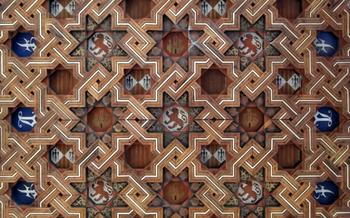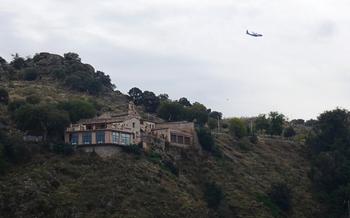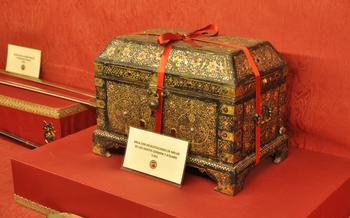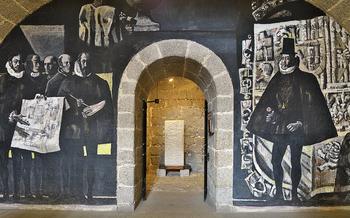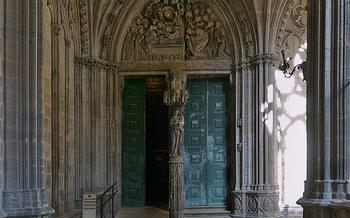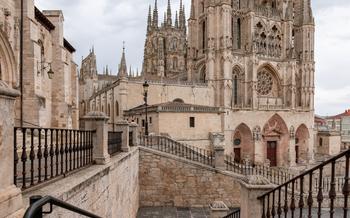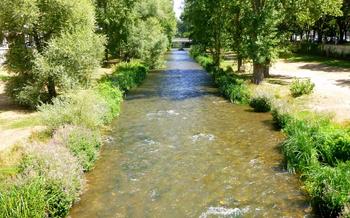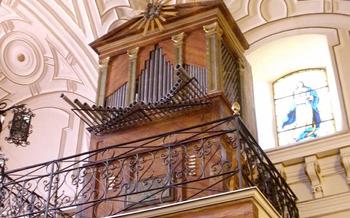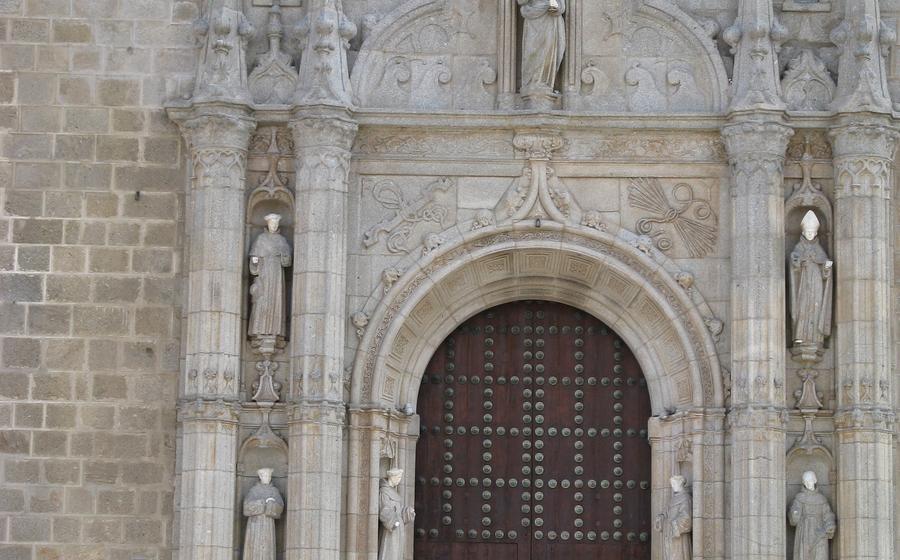
The Church of San Juan Bautista
- The Church of San Juan Bautista: An Architectural Masterpiece
- Awe-Inspiring Exterior: Marveling at the Church's Facade
- Stepping Inside: Discovering the Church's Interior
- A Symphony of Light: Stained Glass Windows and Their Stories
- Artistic Treasures: Exploring the Church's Art Collection
- The Altar: A Symbol of Faith and Devotion
- The Choir: A Place of Harmony and Worship
- The Sacristy: A Hidden Gem of Ecclesiastical Treasures
- The Tower: A Beacon of Faith and a Symbol of Strength
- The Cloister: A Peaceful Oasis in the Heart of the Church
- Special Events and Celebrations: A Time for Festivities and Faith
- A Living Legacy: The Church in the 21st Century
- Tips for Visitors: Making the Most of Your Visit
- Insider Tip: Uncovering Hidden Secrets
The Church of San Juan Bautista: An Architectural Masterpiece
The Church of San Juan Bautista stands as a testament to the architectural brilliance of the Gothic era, a period characterized by its soaring spires, intricate stone carvings, and expansive stained glass windows. With its construction beginning in the 15th century, the church boasts a rich history deeply intertwined with the development of the city of Toledo.
Located in the heart of the historic center, just a short walk from the iconic Toledo Cathedral, the Church of San Juan Bautista is a must-see destination for anyone interested in exploring the city's architectural heritage. Its stunning facade, adorned with intricate carvings and a magnificent rose window, immediately captures the attention of visitors, inviting them to step inside and discover the awe-inspiring beauty that lies within.
Awe-Inspiring Exterior: Marveling at the Church's Facade
The exterior of the Church of San Juan Bautista is a testament to the grandeur and artistry of Gothic architecture. The main facade, facing the Plaza Mayor, is a masterpiece of intricate carvings, delicate tracery, and soaring spires.
The facade is divided into three vertical sections, each adorned with a magnificent rose window. The central rose window, the largest and most elaborate, features intricate stained glass depicting scenes from the life of Jesus Christ. The two smaller rose windows on either side depict scenes from the Old Testament and the New Testament, respectively.
The facade is further embellished with a multitude of sculptures and carvings, each with its own unique symbolism and meaning. Gargoyles, grotesque creatures with human-like features, adorn the roofline, serving as both a decorative element and a functional water spout. Statues of saints, apostles, and angels occupy niches and buttresses, adding to the overall grandeur of the facade.
A comparison with other Gothic churches reveals the unique characteristics of the Church of San Juan Bautista. While it shares many similarities with other Gothic churches in terms of its overall structure and design, the Church of San Juan Bautista stands out for its intricate carvings, delicate tracery, and the harmonious blend of architectural elements.
Stepping Inside: Discovering the Church's Interior
As you cross the threshold of the Church of San Juan Bautista, prepare to be captivated by its awe-inspiring interior. The church's layout is a testament to the architectural genius of its designers, with the nave stretching out before you in all its grandeur. Its soaring height and intricate ribbed vaults create a sense of spaciousness and majesty that is simply breathtaking. The nave is flanked by elegant side chapels, each dedicated to a different saint or religious figure, adding to the richness and diversity of the church's interior.
The transept, which intersects the nave, forms the central axis of the church, drawing your attention to the intricate details and artistic highlights that adorn this sacred space. Here, you'll find stunning stained glass windows depicting biblical scenes and narratives, casting a kaleidoscope of colors that illuminate the interior with a divine glow. The transept also houses several notable works of art, including sculptures, paintings, and frescoes, which contribute to the church's overall aesthetic appeal.
A Symphony of Light: Stained Glass Windows and Their Stories
The Church of San Juan Bautista is adorned with exquisite stained glass windows that bathe the interior in a kaleidoscope of colors. These windows are not merely decorative; they are intricate works of art that narrate biblical scenes and convey profound religious messages.
The stained glass windows depict a variety of subjects, from the life of Jesus Christ to the stories of the saints. The vibrant hues and intricate details bring these narratives to life, allowing visitors to experience the stories in a tangible way.
One of the most striking windows depicts the Crucifixion, with Jesus Christ hanging on the cross, surrounded by the Virgin Mary and St. John the Evangelist. The window's deep reds and blues create a sense of drama and emotion, capturing the profound sacrifice and suffering of Jesus.
Another notable window portrays the Annunciation, where the angel Gabriel visits Mary to announce the birth of Jesus. The window's delicate colors and soft light convey a sense of serenity and grace, highlighting the miraculous nature of the event.
The stained glass windows in the Church of San Juan Bautista are not just decorative elements; they are powerful tools for storytelling and spiritual reflection. They invite visitors to contemplate the mysteries of faith, to connect with the divine, and to find inspiration and solace in the stories of the saints and the life of Jesus Christ.
Artistic Treasures: Exploring the Church's Art Collection
The Church of San Juan Bautista is not only an architectural marvel but also home to a remarkable collection of artworks that reflect the rich artistic heritage of Spain. Among the most notable pieces are the paintings and sculptures that adorn the church's interior, each contributing to the overall spiritual and aesthetic experience.
One of the highlights is the altarpiece, a masterpiece of Renaissance art. Created by a renowned artist of the time, the altarpiece features intricate carvings, vibrant colors, and lifelike figures that depict biblical scenes and narratives. The altarpiece serves as a focal point for worshipers and visitors alike, capturing their attention with its beauty and symbolism.
The church also boasts an impressive collection of frescoes that adorn its walls and ceiling. These frescoes depict religious themes, such as the life of Jesus Christ, the Virgin Mary, and various saints. The vibrant colors and skillful brushwork of the frescoes bring the stories to life, creating a sense of awe and inspiration for those who behold them.
The influence of different artistic styles can be seen throughout the church, reflecting the diverse cultural and historical influences that have shaped Toledo over the centuries. From the Gothic arches and ribbed vaults to the Renaissance altarpiece and frescoes, the church showcases a harmonious blend of architectural and artistic traditions.
Visitors to the Church of San Juan Bautista are encouraged to take the time to explore and appreciate its artistic treasures. Whether it is the intricate details of the altarpiece, the vivid colors of the frescoes, or the serene beauty of the sculptures, the church's art collection offers a unique glimpse into the artistic and spiritual heritage of Spain.
The Altar: A Symbol of Faith and Devotion
The main altar of the Church of San Juan Bautista stands as a captivating centerpiece, radiating an aura of faith and devotion. Crafted with meticulous artistry, the altar is a testament to the church's rich history and enduring significance.
At the heart of the altar, a beautifully carved wooden altarpiece depicts scenes from the life of Jesus Christ, narrating his birth, crucifixion, and resurrection. The intricate details and vibrant colors bring the biblical stories to life, inviting the faithful to contemplate the profound mysteries of Christianity.
The altar's symbolism extends beyond its visual splendor. The central tabernacle, adorned with precious metals and gemstones, serves as a reminder of the Eucharist, the sacred sacrament of communion. Here, the bread and wine are transformed into the body and blood of Christ, emphasizing the church's role as a place of worship and spiritual nourishment.
The materials used in the construction of the altar reflect the devotion and craftsmanship of the artisans who created it. Finely carved wood, intricate metalwork, and shimmering fabrics combine to create a harmonious ensemble that exudes both grandeur and reverence.
The altar of the Church of San Juan Bautista is not merely an object of artistic admiration but also a focal point of religious devotion. It serves as a sacred space where the faithful gather to offer prayers, receive sacraments, and deepen their connection with the divine.
The Choir: A Place of Harmony and Worship
The choir of the Church of San Juan Bautista is a masterpiece of Gothic architecture and craftsmanship. Located in the center of the church, it is enclosed by intricately carved wooden stalls that create a sense of awe and grandeur. The stalls are adorned with delicate tracery, pinnacles, and sculptures depicting biblical scenes and figures.
The choir's primary function is to provide a space for the church's choir to perform during religious services. The stalls are arranged in two rows, with the cantors and soloists seated in the front row. The choir's singing adds a layer of solemnity and beauty to the church's services, creating an atmosphere of devotion and reverence.
Beyond its musical significance, the choir also holds historical and artistic importance. The carvings on the choir stalls are exquisite examples of Gothic art, showcasing the skill and artistry of the craftsmen who created them. Each stall is unique, featuring intricate details such as angels, saints, and biblical scenes. The choir stalls are a testament to the dedication and craftsmanship of the church's builders, and they continue to inspire awe and admiration in visitors today.
The Sacristy: A Hidden Gem of Ecclesiastical Treasures
The sacristy of the Church of San Juan Bautista serves as a hidden repository of ecclesiastical treasures, preserving a collection of precious objects used in religious ceremonies and rituals. Step into this sacred space, revealing a treasure trove of liturgical artifacts, vestments, and religious paraphernalia.
Among the highlights of the sacristy are the intricately embroidered vestments, adorned with gold thread and precious gemstones. These garments are worn by priests and other clergy during holy ceremonies and processions. The collection also boasts a range of chalices, ciboria, and other vessels used for administering the sacraments, each crafted with exquisite artistry and attention to detail.
In addition to liturgical objects, the sacristy houses a number of religious artifacts of great significance. These may include relics of saints, fragments of holy objects, or items associated with important historical or spiritual figures. These relics are often displayed in ornate reliquaries or displayed in special niches within the sacristy.
The sacristy also serves as a functional space within the church, where priests and other clergy can prepare for and conduct religious services. It is here that they don their vestments, light candles, and gather the necessary items for the liturgy. The sacristy is thus an essential part of the church's daily life, providing a sacred space for the preparation and execution of religious rituals.
The Tower: A Beacon of Faith and a Symbol of Strength
The tower of the Church of San Juan Bautista stands tall and proud, a beacon of faith and a symbol of strength. This impressive structure, reaching towards the heavens, is a testament to the architectural prowess of the church's builders. Its sturdy walls, adorned with intricate carvings and sculptures, have withstood the test of time, remaining a prominent landmark in the Toledo skyline.
The tower served as a watchtower in the past, providing a strategic vantage point for spotting approaching enemies or fires. Today, it invites visitors to climb its winding staircase, offering breathtaking panoramic views of the city and the surrounding countryside. From this elevated perspective, one can appreciate the grandeur of the church's architecture, the tapestry of red-tiled roofs stretching out below, and the distant mountains blending into the horizon.
In addition to its practical function, the tower holds symbolic significance. It represents the church's unwavering faith and its role as a spiritual beacon, guiding the faithful on their journey towards salvation. Its presence reminds the community of the enduring strength of their beliefs and the importance of looking beyond earthly concerns towards the heavens.
The Cloister: A Peaceful Oasis in the Heart of the Church
Nestled in the heart of the Church of San Juan Bautista, the cloister serves as a tranquil sanctuary, an oasis of serenity amidst the bustling city. Constructed in the 14th century, this architectural gem showcases the harmonious blend of Gothic and Renaissance styles. Its serene atmosphere invites visitors to pause, reflect, and connect with their inner selves.
The cloister's graceful arches and intricate tracery windows create an ethereal ambiance. Its central courtyard, adorned with lush greenery and a serene fountain, provides a haven for contemplation and meditation. In the past, the cloister served as a place of retreat and study for the monks who resided within the church's walls.
As you wander through the cloister's arcaded walkways, take a moment to appreciate the exquisite carvings that adorn the capitals of the columns. These intricate depictions of biblical scenes and mythical creatures narrate stories of faith and devotion, adding depth and meaning to the cloister's sacred space.
The cloister's serene atmosphere and captivating beauty have made it a popular destination for visitors seeking a moment of respite from the bustling city streets. Whether you are a history buff, an architecture enthusiast, or simply seeking a tranquil space for reflection, the cloister of the Church of San Juan Bautista offers a sanctuary for the soul.
Special Events and Celebrations: A Time for Festivities and Faith
The Church of San Juan Bautista is not only a place of worship but also a venue for various special events and celebrations that showcase its vibrant religious and cultural heritage. Throughout the year, the church comes alive with festivals, concerts, and performances that draw both locals and tourists alike.
One of the most significant events is the annual Corpus Christi procession, which takes place in June. During this colorful and lively festival, the streets of Toledo are adorned with intricate flower carpets, and a grand procession carrying the Eucharist winds its way through the city, passing by the church.
The church is also a popular venue for concerts and cultural performances. Classical music concerts, organ recitals, and choral performances often fill the air with beautiful melodies, enhancing the church's already awe-inspiring atmosphere.
Throughout the year, the church hosts various religious celebrations, including masses, weddings, and baptisms, which provide visitors with a glimpse into the deep faith and devotion that permeates the community.
These special events and celebrations not only showcase the rich traditions of the church but also serve as a reminder of its enduring role as a gathering place for the community, fostering a sense of unity and belonging among the people of Toledo.
A Living Legacy: The Church in the 21st Century
In the 21st century, the Church of San Juan Bautista continues to play a vital role in the religious, cultural, and historical landscape of Toledo. It remains an active place of worship, hosting daily masses, special services, and religious festivals. The church's ongoing preservation and conservation efforts ensure that its architectural integrity and artistic treasures are protected for future generations.
As a symbol of Toledo's rich heritage, the church attracts a steady stream of tourists and pilgrims from around the world. Visitors marvel at its stunning architecture, explore its fascinating history, and find solace and inspiration within its sacred walls. The church's enduring significance lies in its ability to bridge the past and the present, serving as a living testament to the enduring power of faith and devotion.
Tips for Visitors: Making the Most of Your Visit
To fully appreciate the beauty and significance of the Church of San Juan Bautista, it's essential to plan your visit wisely. The church is open to the public daily, but certain times may be more suitable depending on your preferences. If you prefer a quieter atmosphere, consider visiting during the early morning or late afternoon hours when there are fewer crowds. Remember to dress respectfully, as the church is an active place of worship. While photography is generally allowed, it's important to be mindful of other visitors and avoid using flash or taking photos during services or religious ceremonies. Guided tours are available for a more in-depth exploration of the church's history and architecture. These tours provide valuable insights and allow you to ask questions. However, if you prefer a self-guided tour, you can purchase a guidebook or download an audio guide to accompany you on your journey. Follow the designated paths and signage to ensure you don't miss any important features. By adhering to these guidelines, you can create a meaningful and enjoyable visit to the Church of San Juan Bautista.
Insider Tip: Uncovering Hidden Secrets
Beyond the main attractions, the Church of San Juan Bautista holds a treasure trove of hidden secrets that are waiting to be discovered by curious explorers. Secret passageways and hidden chambers, accessible to those who dare to venture off the beaten path, reveal a fascinating world of history and intrigue. Little-known stories and anecdotes, passed down through generations, add a touch of mystery to the church's legacy. Discover the forgotten corners, the intricate carvings that hold symbolic meanings, and the hidden messages concealed within the church's architecture. As you explore, let your imagination soar and embrace the magic of uncovering the secrets that lie beneath the surface of this magnificent edifice.


